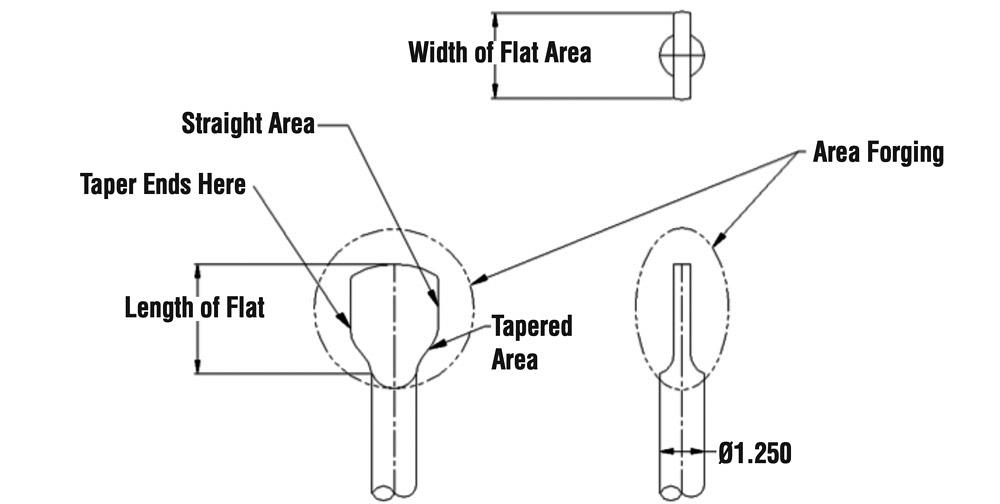- FMA
- The Fabricator
- FABTECH
- Canadian Metalworking
Categories
- Additive Manufacturing
- Aluminum Welding
- Arc Welding
- Assembly and Joining
- Automation and Robotics
- Bending and Forming
- Consumables
- Cutting and Weld Prep
- Electric Vehicles
- En Español
- Finishing
- Hydroforming
- Laser Cutting
- Laser Welding
- Machining
- Manufacturing Software
- Materials Handling
- Metals/Materials
- Oxyfuel Cutting
- Plasma Cutting
- Power Tools
- Punching and Other Holemaking
- Roll Forming
- Safety
- Sawing
- Shearing
- Shop Management
- Testing and Measuring
- Tube and Pipe Fabrication
- Tube and Pipe Production
- Waterjet Cutting
Industry Directory
Webcasts
Podcasts
FAB 40
Advertise
Subscribe
Account Login
Search
Ask the Stamping Expert: How do I calculate press tonnage for swaging?
- By Thomas Vacca
- November 30, 2015
- Article
- Bending and Forming
Q: We are in the process of quoting a new job for the swaging and stamping of copper rod. To do this job, we need to buy a hydraulic press. The goal is to deform copper rods into a flat form on one of the edges. How do we calculate how much press tonnage we need?
A: Obviously I would need a lot more information to calculate the force required. However, in general, the tonnage is equal to the final flattened area multiplied by the compression strength of the copper.
If you are starting with a round copper rod, it will taper wide when you swage it and then reach a point where the swage runs straight. The area is determined by the oblong final shape of the swage after the tapered portion ends. At this point the perimeter of the swaged shape is equal to the perimeter of the original round diameter of the rod.
First, measure the width of the flat. Then multiply that width by the length to be flattened to determine the area. The compressive ultimate strength of the copper is equal to the tensile strength multiplied by a factor of 1.2 to overcome the friction during flattening. Therefore, the formula to determine the tonnage required to swage the part is:
Force = Final flat area x Ultimate tensile strength of copper x 1.2.
The fictitious sketch in Figure 1 serves as an example. All the areas that are required to complete the calculations are identified. This example part uses 1.250-inch-diameter CDA 110 copper rod. The nominal tensile strength of this material is 32,000 pounds per square inch.
Following is the process for completing the calculations:
Flattened area of rod = 6.745 sq. in.
Tensile stress of CDA 110 copper = 32,000 PSI
Compressive strength of CDA 110 copper = 1.2 x Tensile strength = 1.2 x 32,000 = 38,400 PSI
Flattening force = Area x Compressive strength = 6.745 x 38,400 = 259,008 lbs.
Flattening force in tons = 259,008/2,000 = 129.504 tons
Never use a press that is rated for the exact amount of required tonnage you have calculated. Always add a minimum of 20 percent for safety. In this case, the minimum press tonnage should be 155 to 175.
Keep in mind that this formula is valid for all metals, not just for copper.
I would like to acknowledge metal forming expert Bahir Ibrahim for his contribution to this response.
About the Author

Thomas Vacca
Micro Co.
Has a shop floor stamping or tool and die question stumped you? If so, send your questions to kateb@thefabricator.com to be answered by Thomas Vacca, director of engineering at Micro Co.
Related Companies
subscribe now

The Fabricator is North America's leading magazine for the metal forming and fabricating industry. The magazine delivers the news, technical articles, and case histories that enable fabricators to do their jobs more efficiently. The Fabricator has served the industry since 1970.
start your free subscription- Stay connected from anywhere

Easily access valuable industry resources now with full access to the digital edition of The Fabricator.

Easily access valuable industry resources now with full access to the digital edition of The Welder.

Easily access valuable industry resources now with full access to the digital edition of The Tube and Pipe Journal.
- Podcasting
- Podcast:
- The Fabricator Podcast
- Published:
- 04/16/2024
- Running Time:
- 63:29
In this episode of The Fabricator Podcast, Caleb Chamberlain, co-founder and CEO of OSH Cut, discusses his company’s...
- Trending Articles
Capturing, recording equipment inspection data for FMEA

Tips for creating sheet metal tubes with perforations

Are two heads better than one in fiber laser cutting?

Supporting the metal fabricating industry through FMA

Omco Solar opens second Alabama manufacturing facility

- Industry Events
16th Annual Safety Conference
- April 30 - May 1, 2024
- Elgin,
Pipe and Tube Conference
- May 21 - 22, 2024
- Omaha, NE
World-Class Roll Forming Workshop
- June 5 - 6, 2024
- Louisville, KY
Advanced Laser Application Workshop
- June 25 - 27, 2024
- Novi, MI




























